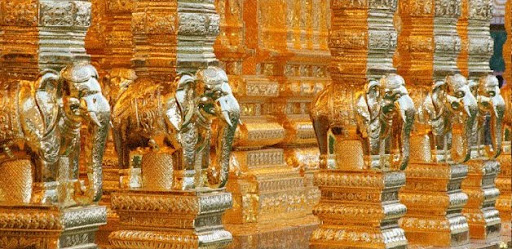The picture shows the urn with the rudimentary Tamil-Brahmi script, and a human skeleton and miniature pots at the Iron Age urn burial site at Adichanallur in Tamil Nadu. The inset with the arrow mark depicts how the script has been written inside the urn. — Photo courtesy: ASI, Chennai Circle.
The Archaeological Survey of India (ASI), Chennai Circle, made this discovery when it resumed its excavation at Adichanallur after about 100 years. Dr. T. Satyamurthy, Superintending Archaeologist and Director of the excavation, first noticed the script. He has proposed that the piece of writing is in very rudimentary Tamil-Brahmi. M.D. Sampath, retired Director, Epigraphy, ASI, Mysore, also "suggested that the writing is in Tamil-Brahmi in a rudimentary form." Dr. Sampath says he has "tentatively read" the script as "Ka ri a ra va [na] ta." He says the script has seven letters.
"Might date back to 500 B.C."
Dr. Satyamurthy has proposed, on the basis of "preliminary thermo-luminescence dating," that the pottery found at the site, including the pots found in the urn along with the script, might date back to circa 500 B.C. This date is, however, subject to confirmation by carbon-14 dating, which is the more reliable method.
The claim on the date of the script and the assertion that it is in Tamil-Brahmi will be subjected to the scrutiny of scholars in the field.
The term `Tamil-Brahmi' is used when the script is in Brahmi but the language is Tamil. The Brahmi script was predominantly used for Prakrit from the Mauryan (Asokan) period. The Brahmi script was brought to the Tamil country in the third century B.C. by the Jain and Buddhist monks during the post-Asokan period.
According to Iravatham Mahadevan, one of the foremost authorities on the Tamil-Brahmi script: "The Brahmi script reached Upper South India (Andhra-Karnataka regions) and the Tamil country at about the same time during the 3rd century B.C. in the wake of southern spread of Jainism and
Buddhism." In his magnum opus, Early Tamil epigraphy, From the Earliest Times to the Sixth Century A.D., Mr. Mahadevan says that "the earliest Tamil inscriptions in the Tamil-Brahmi script may be dated from about the end of 3rd century or early 2nd century B.C. on palaeographic grounds and stratigraphic evidence of inscribed pottery. The earliest inscriptions in the Tamil country written in the Tamil-Brahmi script are almost exclusively in the Tamil language."
While Upper South India was under the sway of the Nanda-Maurya domain, the Tamil country was politically independent. As a result of political independence, Tamil was the language of administration in the Tamil country. "When writing became known to the Tamils, the Brahmi script was adapted to suit the Tamil phonetic system. That is, while the Brahmi script was borrowed, the Prakrit language was not allowed to be imposed along with it from outside," says Mr. Mahadevan.
Dr. Satyamurthy, however, proposes that the script found inside the urn may belong to circa 5th century B.C. According to him, this was based on "preliminary thermo-luminescence dating," which "takes the site to the period from 1500 B.C. to 500 B.C. So the script is also likely to be dated to 5th century B.C. even if we take the latest date into consideration."
Name of hero?
He pointed out that the Tamil-Brahmi script had been found in Sri Lanka too. The script found at Adichanallur could be the name of the hero whose skeleton is in the urn. "The associated pottery including the thin black and red ware [found in the urn] indicate the importance given to the dead person," he said. The denture has been sent to the Anthropological Survey of India for examination.
Delivering the T. Balakrishna Nair Memorial Lecture on "The geneses and features of Brahmi scripts," organised on January 12 by the Department of Ancient History and Archaeology, Madras University, Dr. Sampath said: "It may be suggested that the writing is in Tamil-Brahmi script in a rudimentary form. Attempts were made to blow up the writing so as to decipher it. It may be tentatively read as, `Ka ri a ra va [na] ta'. The reading is subject to improvement."
"A rare occurrence"
Estampages of the script could not be taken because it was inside the urn. So eye-copies were taken. Although the exact meaning of the script was not clear, it was quite likely to be the name of the engraver or the maker of the urn or the person whose skeletal remains were interred inside, he said. He described the script found inside the urn as "a rare occurrence."
Six trenches dug by the ASI, Chennai Circle, at the Iron Age urn burial site Adichanallur in 2004 yielded a cornucopia: 157 burial urns, 50 of them intact and 15 with human skeletons. The urns with skeletons had exquisite miniature pots inside along with paddy and husk. Around the urns were ritual pots and iron implements, including daggers, broken swords, a spearhead, celts and so on. One of the urns had the script inside it and this urn had a big lid too. It is called "twin pot."













